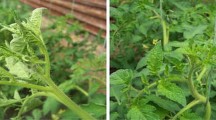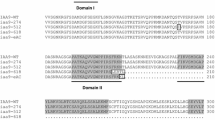Abstract
Lycopersicon esculentum accessions bearing fasciated (multiloculed) fruit were characterized based on their flower organ and locule number phenotypes. Greenhouse and field evaluations indicate that increases in locule number are associated with increases in the number of other floral organs (e.g., sepals, petals, stamens) in all stocks. F1 complementation, F2 segregation analysis, and genetic mapping indicate that at least four loci account for increases in the number of carpels/locules in these stocks. The most significant of these map to the bottoms of chromosomes 2 and 11 and correspond to the locule number and fasciated loci. All stocks tested were fixed for mutations at the fasciated locus, which maps to the 0.5-cM interval between the markers T302 and cLET24J2A and occurs in at least three allelic forms (wild type and two mutants). One of the fasciated mutant alleles is associated with nonfused carpels and repressed recombination and may be due to a small inversion or deletion. The other two loci controlling locule number correspond to the lcn1.1 and lcn2.2 loci located on chromosomes 1 and 2, respectively.





Similar content being viewed by others
References
Ahuja R (1968) Diallel analysis of locule number in tomato. II. Indian J Genet Plant Breed 28:323–331
Bernatzky R, Tanksley S (1986) Toward a saturated linkage map in tomato based on isozymes and random cDNA sequences. Genetics 112:887–898
Butler L (1952) The linkage map of the tomato. J Hered 43:25–35
Chaudhary R, Khanna K (1972) Inheritance of locule number in a cross in tomato (Lycopersicon esculentum Mill.). Indian J Agric Sci 42:786–789
Clark S, Williams R, Meyerowitz E (1997) The CLAVATA1 gene encodes a putative receptor kinase that controls shoot and floral meristem size in Arabidopsis. Cell 89:575–585
Cong B, Liu J, Tanksley S (2002) Natural alleles at a tomato fruit size quantitative trait locus differ by heterochronic regulatory mutations. PNAS 99:13606–13611
Das M, Mallavarapu G, Kumar S (1999) Isolation of a genotype bearing fasciated capitula in chamomile Chamomilla recutita. J Med Aromat Plant Sci 21:17–22
Dennet R, Larson R (1953) The inheritance of fruit shape, locule number, and stem color in derivatives of a hybrid of Lycopersicon esculentum by L. peruvianum. TGC Report No. 3, p 10
Eshed Y, Zamir D (1995) An introgression line population of Lycopersicon pennellii in the cultivated tomato enables the identification and fine mapping of yield associated QTL. Genetics 141:1147–1162
Fletcher J, Brand U, Running M, Simon R, Meyerowitz E (1999) Signaling of cell fate decisions by CLAVATA3 in Arabidopsis shoot meristems. Science 283:1911–1914
Fogle H, Currence T (1950) Inheritance of fruit weight and earliness in a tomato cross. Genetics 35:363–380
Frary A, Nesbitt T, Frary A, Grandillo S, van der Knaap E, Cong B, Liu J, Meller J, Elber R, Alpert K, Tanksley S (2000) fw2.2: a quantitative trait locus key to the evolution of tomato fruit size. Science 289:85–88
Fulton T, Chunwongse J, Tanksley S (1995) Microprep protocol for extraction of DNA from tomato and other herbaceous plants. Plant Mol Biol Rep 13:207–209
Gottschalk W (1977) Fasciated peas unusual mutants for breeding and research. J Nucl Agri Bio 6:27–32
Grandillo S, Ku H, Tanksley S (1999) Identifying the loci responsible for natural variation in fruit size and shape in tomato. Theor Appl Genet 99:978–987
Ibarbia E, Lambeth V (1969) Inheritance of soluble solids in a large/small-fruited tomato cross. J Am Soc Hort Sci 94:496–498
Jacobsen S, Meyerowitz E (1997) Hypermethylated SUPERMAN epigenetic alleles in Arabidopsis. Science 277:1100–1103
Jeong S, Trotochaud A, Clark S (1999) The Arabidopsis CLAVATA2 gene encodes a receptor-like protein required for the stability of the CLAVATA1 receptor-like kinase. Plant Cell 11:1925–1933
Knaap E van der, Tanksley S (2003) The making of a bell pepper-shaped tomato fruit: identification of loci controlling fruit morphology in Yellow Stuffer tomato. Theor Appl Genet 107:139–147
Kosambi D (1944) The estimation of map distances from recombination values. Ann Eugen 12:172–175
Lander E, Green P, Abrahamson J, Barlow A, Daly M, Lincoln S, Newburg L (1987) MAPMAKER: an interactive computer package for constructing primary genetic linkage maps of experimental and natural populations. Genomics 1:174–181
Leffel R, Bernard R, Yocum J (1993) Agronomic performance of fasciated soybean genotypes and their isogenic lines. Crop Sci 33:427–432
Lippman Z, Tanksley S (2001) Dissecting the genetic pathway to extreme fruit size in tomato using a cross between the small-fruited wild species Lycopersicon pimpinellifolium and L. esculentum var. Giant Heirloom. Genetics 158:413–422
Liu J, Cong B, Tanksley S (2003) Generation and analysis of an artificial gene dosage series in tomato to study the mechanisms by which the cloned quantitative trait locus fw2.2 controls fruit size. Plant Physiol 132:292–299
MacArthur J (1926) Linkage studies with the tomato. Genetics 11:387–405
MacArthur J (1928) Linkage studies with the tomato. II. Three linkage groups. Genetics 13:410–420
MacArthur J (1934) Linkage groups in the tomato. J Genet 29:123–133
MacArthur J, Butler L (1938) Size inheritance and geometric growth processes in the tomato fruit. Genetics 23:253–268
Mayer K, Schoof H, Haecker A, Lenhar M, Jürgens G, Laux T (1998) Role of WUSCHEL in regulating stem cell fate in the Arabidopsis shoot meristem. Cell 95:805–815
Myers C (1943) The Pennheart tomato. Penn Exp STA Bull 438:1–10
Nelson J (1997) QGENE: software for marker based genomic analysis and breeding. Mol Breed 3:229–235
Nesbitt T, Tanksley S (2001) fw2.2 directly affects the size of developing tomato fruit, with secondary effects on fruit number and photosynthate distribution. Plant Physiol 127:575–583
Nesbitt T, Tanksley S (2002) Comparative sequencing in the genus Lycopersicon. Implications for the evolution of fruit size in the domestication of cultivated tomatoes. Genetics 162:365–379
Ori N, Eshed Y, Paran I, Presting G, Aviv D, Tansley S, Zamir D, Fluhr R (1997a) The I2C family from the wilt disease resistance locus I2 belongs to the nucleotide binding, leucine-rich repeat superfamily of plant resistance genes. Plant Cell 9:521–532
Ori N, Eshed Y, Pinto P, Paran I, Zamir D, Fluhr R (1997b) TAO1, a representative of the molybdenum cofactor containing hydroxylases from tomato. J Biol Chem 272:1019–1025
Powers L (1941) Inheritance of quantitative characters in crosses involving two species of Lycorpersicon. J Agric Res 63:149–174
Powers L, Locke L, Garrett J (1950) Partitioning method of genetics analysis applied to quantitative characters of tomato crosses. Tech Bull US Dept Agric 998:1–56
Rick C (1965) A dominant allele at the f locus. TGC Report No. 15, p 50
Rick C, Butler L (1956) Cytogenetics of the tomato. Adv Genet 8:267–382
Schoof H, Lenhard M, Haecker A, Mayer K, Jürgens G, Laux T (2000) The stem cell population of Arabidopsis shoot meristems is maintained by a regulatory loop between the CLAVATA and WUSCHEL genes. Cell 100:635–644
Szymoniack E, Sussex I (1992) The internal meristem layer (L3) determined floral meristem size and carpel number in tomato periclinal chimeras. Plant Cell 4:1089–1100
Tanksley S, Ganal M, Prince J, de Vicente M, Bornievale M, Broun P, Fulton T, Giovannoni J, Grandillo S, Martin G, Messeguer R, Miller J, Miller L, Paterson A, Pineda O, Roder M, Wing R, Wu W, Young N (1992) High density molecular linkage maps of the tomato and potato genomes. Genetics 132:1141–1160
Yeager A (1937) Studies on the inheritance and development of fruit size and shape in the tomato. J Agric Res 55:141–152
Young P, MacArthur J (1947) Horticultural characters of tomatoes. Texas Agric Exp Stn Bull No. 698
Zielinski Q (1945) Fasciation in horticultural plants with special reference to tomato. Proc Am Soc Hort Sci 46:263–268
Zielinski Q (1948) Fasciation in Lycopersicon. I. Genetic analysis of dominance modification. Genetics 33: 405–428
Acknowledgements
We thank Drs. E. van der Knaap and B. Cong for comments on the manuscript. We also thank C. de Sousa and N. van Eck for excellent technical assistance, and Dr. F. Vermeylen for help with the multidimensional scaling analysis. This work was supported by grants from the National Research Initiative Cooperative Grants Program, US Department of Agriculture Plant Genome Program (no. 0035300-9264); the National Science Foundation (no. 0116076); and the Binational Agricultural Research and Development Fund (no. IS-3009-980). L. Barrero was supported by a Fulbright–Colciencias scholarship.
Author information
Authors and Affiliations
Corresponding author
Additional information
Communicated by G. Wenzel
Rights and permissions
About this article
Cite this article
Barrero, L.S., Tanksley, S.D. Evaluating the genetic basis of multiple-locule fruit in a broad cross section of tomato cultivars. Theor Appl Genet 109, 669–679 (2004). https://doi.org/10.1007/s00122-004-1676-y
Received:
Accepted:
Published:
Issue Date:
DOI: https://doi.org/10.1007/s00122-004-1676-y




